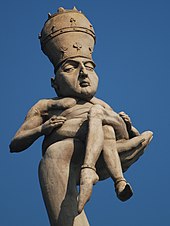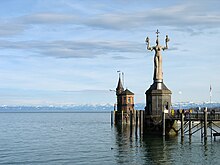Imperia (statue)
The Imperia is a statue in the port of Konstanz on Lake Constance , designed and executed by the sculptor Peter Lenk and erected in 1993. The figure is cast from concrete , nine meters high, weighs 18 tons and rotates once around its own axis within four minutes with the help of a rotary table . A level measuring station is integrated in its base , which is surrounded by a walkway.
symbolism
The statue of Imperia is a satirical reminder of the Council of Constance (1414–1418). It shows a luscious courtesan , who gives a deep cleavage and a cape, which is only tightly closed by a belt, a clear erotic charisma.
In her raised hands she carries two dwarfish naked men. The man in her right hand wears the crown of a king on his head and holds an orb in his hand; the figure on her left is wearing a papal tiara and is seated with crossed legs. It is not clear whether the figures represent portraits of the rulers at the time of the Council of Constance, Emperor Sigismund and Pope Martin V , or whether they are generally intended to represent secular and spiritual power as personifications . The artist himself sees them as naked jugglers who have illegally donned the insignia of power.
“… The characters of Imperia are not the Pope or the Emperor, but rather jugglers who have appropriated the insignia of secular and spiritual power. And to what extent the real popes and emperors were also jugglers, I leave to the historical education of the viewer. ... "
This constellation of figures is reminiscent of the alleged rule of mistresses , which the Roman official church was accused of by its most violent critics at times. The patriarchy , which has ruled both politics and the church for centuries, is also targeted: the emperor and the pope are the plaything of their own libido ; the most powerful men are ruled by their lowest instincts . Imperia, as the embodiment of (physical) love, appears as the actually powerful figure.
The work of art also uses the old fairy tale material “ The Emperor's New Clothes ”: The Imperia headdress is a kind of fool's cap with bells - Imperia not only takes on the role of the scheming courtesan, but also that of the court jester who sees through the game of the mighty and pokes fun at it. The powerful, when they are robbed of their dignified official costume, are only ridiculous figures of joke.
Material history

Peter Lenk took the immediate literary model for the statue from a story by Honoré de Balzac . In his frivolous story La belle Impéria (published in the Tolldreisten Stories , 1832–1837) the beautiful Imperia is a courtesan who stayed here during the Council of Constance . Imperia is the beloved of “ cardinals , dignitaries, princes and margraves ” and turns out to be the secret ruler of the council: “The highest and the boldest wooed her, a wink from her could cost you your life, and even inexorable virtues crept up on her the glue and, like the others, danced to their tune. ”Balzac targets the double standards of the clergy of the Catholic Church . The heroes of his story are the sensual Imperia and a “poor little Pfäfflein”, a young, naive clergyman who falls in love with her.
Balzac's story is based on literary sources associated with a historical person. Before Balzac made use of the material, Imperia appeared as a literary figure with the writers Matteo Bandello , Joachim du Bellay and François Béroalde de Verville . The historical person to whom the literary tradition refers was Imperia Cognati (1481–1512), also called the Divine Imperia . Imperia, however, lived almost a century after the council - her appearance there as courtesan is an invention of Balzac. The historical Imperia was an educated Italian who was famous during her lifetime and entered the literature and historiography of the Italian Renaissance . Pietro Aretino praised her education: "(S) he knows by heart all of Petrarch and Boccaccio and countless beautiful Latin verses from Virgil , Horace , Ovid and a thousand other authors". Imperia seems to have been, contemporaries believe, an influential lover of high-ranking clerics, but also of other well-to-do Roman citizens.
Balzac's story was taken up in several works of art in front of Lenk's Imperia statue: In 1925, Lovis Corinth created the frivolous painting The beautiful woman Imperia , which shows the first encounter between Imperia and the “poor little Pfäfflein”. In 1927 Franco Alfano set the story to music in the opera Madonna Imperia .
The historical background of the council prostitutes is not an invention: at the time of the council, which lasted four years, up to 30,000 clergy and princes and their servants, merchants, craftsmen and innkeepers lived next to the Constance city population, which at that time numbered between 5,000 and 7,000 people etc. in the city. In addition, quite a number of prostitutes offered their services during the council . The council writer Ulrich Richental reports: "Public whores in whore houses and those who had rented houses themselves and were in the stables or where they wanted, there were over 700 of them, without the 'secret ones', I leave them countless." In addition to ordinary brothels (one is said to have included around 30 prostitutes) there were also “more upscale” courtesans who rented their own houses. The poet and diplomat Oswald von Wolkenstein also reports on his experiences in the Konstanz brothels .
Emergence
The Imperia was initiated by the tourist association of the city of Konstanz with its chairman Werner Häusler, the Bodensee-Schiffsbetriebe (then owned by Deutsche Bahn ) and the landlords.
The concept of the work of art developed gradually in discussions. The idea of a female figure was initiated by the Statue of Liberty in New York. Lenk developed the idea of a smaller, not so pathetic "brisk madame" and the dignitaries on their hands in a conversation with his wife. After reading Balzac, a friend finally contributed the idea of the Imperia. There is a smaller model of the sculpture.
Its base used to belong to a pier tower at the port of Constance, which was built in 1842 and torn down again in 1890 - with the exception of the small base house that still exists today. The level measuring station has even existed since 1816, making it the oldest in Baden-Württemberg today . For a long time there was only a steel frame on the base, which served as a beacon . It had to give way to the Imperia.
Lenk rented a hall in Stuttgart and designed the Imperia there. The individual parts of the statue were transported by a ferry from Friedrichshafen with the train as the owner and not by a city ferry in Constance in a night and fog action, assembled and then covered. Several thousand people were present at the port for the inauguration on April 24, 1993. The statue was revealed piece by piece.
The statue was initially highly controversial. Above all, the churches of Constance and conservative city councils protested against the elevation of a prostitute to a memorial and against the depiction of the Pope, which was perceived as too crude, and the Archdiocese of Freiburg spoke up with reservations. One of the opponents was the Kunstverein, which questioned the artistic quality of the statue.
However, since the statue was erected on the private property of Deutsche Bahn and not on urban land, it was not possible for the local council to prevent its construction. The monument protection authorities saw no impairment of the city skyline in the statue. However, the Imperia soon developed into a tourist attraction and a symbol of the city. It is also likely to be the world's largest monument to a prostitute.
Lenk made a copy of the naked Pope for the new tourist information office in Konstanz train station . She was also heavily criticized. The board of directors of the tourism company, chaired by Mayor Horst Frank , decided in mid-2010 to remove the sculpture; shortly afterwards it was removed.
financing
The construction was sponsored by the Computer Gesellschaft Konstanz (CGK). Therefore, the base of the Imperia still bears a CGK logo, but the company now operates under a different name.
literature
- Helmut Weidhase: Imperia. Constance harbor figure. Stadler, Konstanz 1997, ISBN 3-7977-0374-0 .
Web links
Individual evidence
- ↑ Peter Lenk, interviewed by Jasmin Hummel: 20 years of Imperia. ... and it's still spinning. In: Labhards Bodensee Magazin 2013, pp. 44–45
- ^ Honoré de Balzac: The beautiful Imperia. In: Project Gutenberg-DE . Retrieved May 16, 2018 .
- ^ Quote from Jacob Burckhardt : The culture of the Renaissance in Italy . Reclam, Stuttgart 1987, p. 429.
- ↑ quote by Helmut Weidhase: Imperia. Constance harbor figure. Stadler, Konstanz 1997, p. 11.
- ↑ a b Andreas Schuler: 25 years and not aged a bit: That is the bizarre story of the Konstanz landmark Imperia. In: Südkurier . April 24, 2018. Retrieved July 26, 2018 .
- ↑ Peter Lenk, interviewed by Jasmin Hummel: 20 years of Imperia. ... and it's still spinning. In: Labhards Bodensee Magazin 2013, p. 44
- ↑ 3D model of the Imperia. (No longer available online.) University of Konstanz, Multimedia Signal Processing group, archived from the original on April 5, 2011 ; accessed on April 3, 2018 .
- ↑ Imperia 3D model at commons.wikimedia.org
- ↑ Water level of the Imperia measuring station in the port of Constance (Rhine area> Lake Constance> Constance) ( Memento from October 24, 2013 in the Internet Archive )
- ↑ Claudia Rindt: When the noble whore's shell fell. In: Südkurier of April 17, 2013.
- ^ Stefan Hupka: Südwest: Naked Konstanz pope figure must be dismantled , in: Badische Zeitung of July 3, 2010, accessed on July 3, 2010
- ↑ End of a satire - Pope figure removed again. In: Augsburger Allgemeine . July 14, 2010, accessed January 8, 2019 .
- ^ Konstanz, Computergesellschaft Konstanz , accessed on January 10, 2011
Coordinates: 47 ° 39 '38.7 " N , 9 ° 10' 52.1" E



